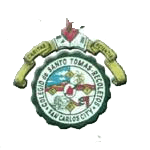Colegio de Santo Tomas – Recoletos
 | |
| Motto | Caritas et Scientia (Latin) |
|---|---|
Motto in English | Charity and Knowledge (Knowledge is the scaffolding of love) |
| Type | Private, Roman Catholic, Augustinian Recollects |
| Established | 1940 |
| Students | 600+ (2015-2016) |
| Location | San Carlos City, Negros Occidental, Philippines |
| Campus | Urban; Main campus |
| Colors | Gold and White |
| Nickname | Tomasian |
| Mascot | Golden Eagle |
| Affiliations | PAASCU |
| Website |
www |
The Colegio de Santo Tomas – Recoletos (colloquially known as Santo Tomas, or CST-R) is the first Recollect school of the world. It used to be known as the Sto. Tomas de Villanueva Institute. Colegio de Sto. Tomas - Recoletos is a private college. It also provides Secondary education for young men and women.
History

On April 19, 1940, during the Provincial Chapter in the old Convent in Intramuros (Manila), the idea of establishing a Center of Learning of the Augustinian Recollect was put forward. The school was to be founded in San Carlos. On September 28, 1940, the Father Provincial sent a circular letter to Recollect Fathers working in the Diocese of Bacolod (covering the whole Negros Island), asking them to help in the construction of the school building.
Fr. Tirso Ruana, OAR was tasked to spearhead the construction. He requested Mr. Eusebio Calderon, the parish organist, to look for a lot where the building would be erected. On October 12, 1940, with the execution of the Absolute Deed of Sale, the Augustinian Recollect Fathers acquired the 13,565 square meter site for Php 4,400 from Don Emilio Broce along Azcona St.eron.
Fr. Provincial of the Province of San Nicolas de Tolentino, Fr. Pedro Garcia, OAR, laid the cornerstone on December 19, 1940. The school was intended a school for boys offering secondary course with its counterpart, Colegio de Sta. Rita, a school for girls, run by the Augustinian Recollect Sisters.
After a year of construction, June 20, 1941, the Solemn Blessing was officiated by Most Rev. Casimiro Lladoc, D.D., Bishop of Bacolod, and was attended by civil and ecclesiastical dignitaries. Three days after, the school was opened with the enrolment of 153 boys. Fr. Pedro Zunzarren, OAR was appointed as the first Rector.
When World War II broke out on December 8, 1941, the school was closed two days after. The school was converted into a hospital and later on, was used by the United States Armed Forces in the Far East as a training camp for Filipino recruits who were later sent to the battlefront. With the entrance of the Japanese Imperial Army in San Carlos, the school passed through their hands, making it their office of War and jail.
In 1945 the school resumed classes with the enrolment of 137 boys. Fr. Gregorio Espiga assumed the Directorship of the school.
On March 4, 1947, the Department of Instruction under the Commonwealth Government of the Philippines granted Government Recognition No. 24, Series of 1947 to Sto. Tomas de Villanueva Institute offering a complete general secondary course (day) with the authority to issue its graduates the secondary school diplomas.
During 1950 to 1952 Santo Tomas de Villanueva Institute opened up Grade V and Grade VI due to lack of classrooms in the public elementary school. Only 27 graduated from the grade school. It was closed after operating for two school years.
In 1966, the college celebrated its Silver Jubilee.
In June 1971, under the directorship of Fr. Anesio Villanueva, CST-R broke its tradition as a High School for boys by its acceptance of girls. Among the 86 graduates, two girls received their diplomas, namely, Manuelita Caballero and Perla Detomal.
In August 1993, the college gained an Accredited Status from the Department of Education, Culture and Sports based on the NCEE (National College Entrance Examination) performance as one of the top 250 schools in the country.
Notable alumni
- Reiven Bulado - actor
Order of Augustinian Recollects (OAR) sister schools[1]
- University of Negros Occidental - Recoletos (Bacolod City)
- University of San Jose - Recoletos (Cebu City)
- San Sebastian College–Recoletos de Manila
- San Sebastian College–Recoletos de Canlubang (Calamba, Laguna)
- San Sebastian College - Recoletos de Cavite
- San Pedro Academy - Recoletos (Caidiocan, Valencia, Negros Oriental)
- San Pedro Academy - Recoletos (Poblacion, Valencia, Negros Oriental)
- Colegio San Nicolas de Tolentino - Recoletos (formerly UNO-R High School Talisay Branch) (Talisay City, Negros Occidental)
Seminary and formation houses
- Santo Tomas de Villanueva Recoletos Formation House (High School) (San Carlos City, Negros Occidental)
- Casiciaco Recoleos Seminary (formerly Seminario Mayor - Recoletos de Baguio) (Philosophy) (Baguio City)
- Recoletos Formation Center (Theology) (Mira-Nila Homes, Quezon City)